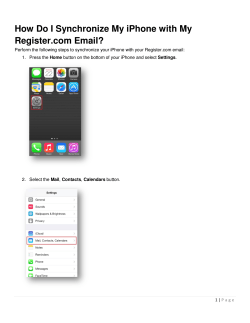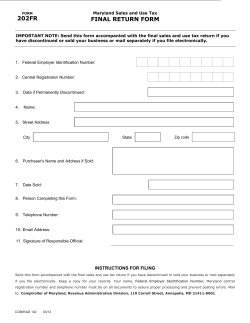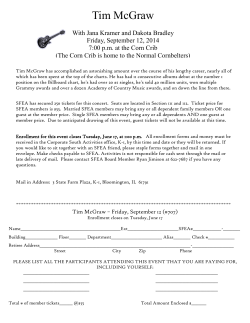
Test Message - HTML Format:Business Idea Zone 14 - How...
Test Message - HTML Format:Business Idea Zone 14 - How to ... http://us.mc339.mail.yahoo.com/mc/showMessage?pSize=25&... Test Message - HTML Format:Business Idea Zone 14 - How to Turn Lions into Lambs Monday, April 12, 2010 11:16 AM From: "Ed Hoy's International" <Ed_Hoy_s_International@mail.vresp.com> To: julieleuck@yahoo.com How to Turn Lions into Lambs It's getting to be that time of year: Stressed out shoppers, returns and exchanges, and just plain unhappy customers. You know the drill: You smile as you unlock the front door of your store ready to greet the hordes of happy customers who will visit you today. Then reality hits you smack in the face when a cheesed off customer demands satisfaction. Welcome to Retailing in the new millennium. Everybody’s in a bad mood. www.kizerandbender.com We are a product of the world that we live in. We’re all time-starved and stressed-out. Mom’s working, Dad’s working, the kid’s are in day care, the bigger one’s are in school. At the end of the work day it’s a mad rush to get Suzie to Girl Scouts and Timmy to basketball. Never mind that you’re tired, you still have to make dinner and do laundry, not to mention help the kid’s with their homework before you can finally relax. No wonder we’re cranky. The thing is those cranky customers can be anyone – we’ve all been not-so-nice customers at one time or another. Most are just nice people who are having a really bad day – you just happen to be the one they decide to take their frustrations out on. If you’re in the retail business then unhappy customers are a daily fact of life. When faced with one you can choose to react or to respond. If you merely react, the customer will most likely stay unhappy. But if you choose to respond in a concerned and professional manner you can turn that lion of a customer into a loyal lamb. Understand that an angry customer may be reacting to what he or she imagines will happen when they present you with a problem. This is part of the emotional baggage every customer brings with them to your store. We’ve all faced snarling store associates who treat customers like the enemy – if a customer has had a bad experience in one of your competitor’s stores, it’s easy to see why they might think they will have 1 of 4 4/12/10 11:44 AM Test Message - HTML Format:Business Idea Zone 14 - How to ... http://us.mc339.mail.yahoo.com/mc/showMessage?pSize=25&... a similar experience in yours. That being said, if the customer is a complete jerk, do yourself a big favor and get him/her off of the sales floor and into an area where you can speak privately. If you stay on the sales floor, where other customers can watch, you’d better be prepared to deliver service perfection, because how you respond will be the topic of the day among customers and associates alike. If the customer is abusive or is using foul language say, “Sir/Madame: I am going to help you, but I cannot help you if you continue to speak to me like that.” If the customer calms down, continue with the steps below to solve their problem. But if the customer continues to berate you, it is perfectly okay to say, “I really do want to help you but I need you to calm down. If you do so I can help you now, otherwise we will have to do this another time.” You can also try politely turning the customer over to another associate. Under “normal” circumstances the following five steps should do the trick: 1. Allow the customer to get the problem off of his chest. Let’s say a customer brings you a problem you can fix in two seconds flat. Resist the urge to save the day, instead let the customer blow off steam. When a customer is unhappy about something, he has a tendency to rehearse what he’s going to say over and over and over on the way to your store. By the time he gets there, his anger is at its peak. If you try to fix the problem without first letting the customer vent, he is likely to wait for a break in the conversation and begin to tell his story all over again. So … * Offer your hand and introduce yourself. Using the customer’s name tends to have a calming effect. * Listen carefully and attentively to the customer’s entire story and don’t interrupt! Stay calm – you set the tome for the rest of the conversation. * Apologize, even if you are not the cause of the problem. This shows the customer you are on their side. If you say, “Gee, this is a great product. We’ve never had this happen before.” The customer hears, “You moron. Didn’t you read the directions?” Instead say, “I am so sorry that you are upset. Let me see what I can do to solve this problem.” Or “I am really sorry this happened to you. I can understand why you are frustrated.” 2. Ask lots of questions to help determine what you should do next. When you ask questions people think you care about them, and they will respond more positively. Ask the customer Open-Ended Questions 2 of 4 4/12/10 11:44 AM Test Message - HTML Format:Business Idea Zone 14 - How to ... http://us.mc339.mail.yahoo.com/mc/showMessage?pSize=25&... that cannot be answered by a simple “yes” or “no”. You might say, “When did you first notice this problem?” Open-ended questions require the customer to talk – and that’s a good thing – because the talking helps the customer to slow down and refocus. Smile, make eye contact, and nod as the customer tells his story. 3. Ask the customer what they would like you to do for them. We witnessed a heated exchange between a store manager and a customer who was trying to return a defective shop vacuum. The stone-faced manager was too busy defending his product to focus on the customer. The manager wasn’t giving an inch, and the customer looked like she was ready to throw the vacuum through the window. Finally, in a sarcastic tone of voice, the manager asked the customer what she’d like him to do. She sighed, and replied that she wanted to exchange the defective vacuum for one that worked. The manager was taken aback. What did he expect she was going to ask for? His first born child? Most customers are not unreasonable; they just want you to fix the problem. Ask, “What would you like me to do for you today?” Then tell the customer exactly what you are going to do on their behalf. Take responsibility: If it’s a problem you can fix on the spot, fix it. If the problem will require further action on your part, then explain which steps you will take, and tell the customer when you will get back to them. And make sure that you follow through! 4. Go a step further and “Do one more thing” for the customer. That “one more thing” is an olive branch that you offer in good faith. It doesn’t matter what you offer, it’s the gesture that counts. A $5.00 gift certificate (80% of all gift certificates are redeemed for more than the face value; 40% of all gift certificates are redeemed for TWICE the face value so you can’t lose); a free class or free crop; or even an inexpensive gift, such as a small photo frame, will work wonders. 5. Follow up to make sure the customer is satisfied. According to The Technical Assistance Research Programs Institute (TARP), up to 70% of unhappy customers will do business with you again, and up to 95% will return if you fix the problem quickly. It’s to your benefit to follow-up. A simple telephone call or handwritten note will do the trick. You may also want to keep a file on what happened, and what you did to take care of the customer. Email us for a free copy of our Super Quick Service Response to help you keep track. 3 of 4 4/12/10 11:44 AM Test Message - HTML Format:Business Idea Zone 14 - How to ... http://us.mc339.mail.yahoo.com/mc/showMessage?pSize=25&... Don’t take it personally! Sometimes that’s easier said than done, but remember you are not the cause of the customer’s frustration – don’t expect to win them all. Do your best not to let an angry customer ruin your entire day or affect the next customer. Make sure that everyone in your organization understands how to work with an unhappy customer. Why not hold a staff meeting using this article as the agenda? Ask your associates to think of a situation they had with an unhappy customer. Ask what they did to solve the problem. Then ask if anyone has a suggestion on what the associate could have done differently. You might want to think up some off-the-wall scenarios of your own, and see how your associates solve them. Ask one associate to be the customer, and another to be the associate. Role play is a great way to get the point across. Customers don’t expect you to be perfect, but they do expect you to fix things when they go wrong. Solving their problems is proof that your store is a trusted partner. It’s that trust that will keep them coming back for more. Continued Success, Maria 1.800.323.5668 info@edhoy.com www.edhoy.com If you no longer wish to receive these emails, please reply to this message with "Unsubscribe" in the subject line or simply click on the following link: Unsubscribe Ed Hoy's International 27625 Diehl Road Warrenville, Illinois 60555 Read the VerticalResponse marketing policy. 4 of 4 4/12/10 11:44 AM
© Copyright 2025





















